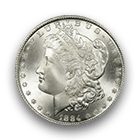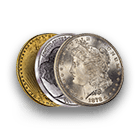What collector, dealer, or investor would “not” like to own a PCGS-graded, key-date, business-strike Morgan Dollar? Why buy PCGS-certified? Because among the entire Morgan Dollar series, key dates are the most copied, counterfeited, altered, and faked with an added mintmark or other manipulations.
This article is meant to explore information about protecting you from spending your hard-earned money on a bogus coin, and by providing some interesting considerations when targeting the purchase of a Morgan Dollar key date or semi-key date.
A Key Date: The 1893-S Morgan Dollar
Perhaps the most desirable key-date Morgan Dollar is the 1893-S. The number of fake coins circulating out there is estimated to exceed the number of genuine specimens. This is because it is the key-date issue commanding the highest value of all Morgan Dollars in just about every grade. In the PCGS Price Guide it lists for $7,000 in a grade of VF20 as of this writing. For reference, the same coin in the same grade was listed for $5,000 in the PCGS Price Guide just five years ago.
Going back 25 years ago, before the PCGS Price Guide was born, one sees an identical specimen would have fetched $1,400 as reported in the 1999 edition of A Guide Book of United States Coins (“The Red Book”), By R.S. Yeoman. Jeff Garrett, who now serves as editor of “The Red Book,” concurs, “Sadly, there is an abundance of counterfeit examples of ‘key date’ Morgan silver dollars, and buying certified coins is highly recommended. Collectors should also learn to use the verification service PCGS offers, as counterfeit holders are sometimes a problem.”
The entire mintage of 1893-S Morgan Dollars was 100,000, all of which was struck with one obverse and two reverse dies. Therefore, all genuine coins can be authenticated as having a small, slightly slanted die line within the central top of the “T” in “LIBERTY” on the obverse. This die line can be seen even on lower-grade coins. If your coin lacks this die line, it is not a genuine coin. This date was not among the dates released by the General Services Administration (GSA), The LaVere Redfield Hoard, or the Continental-Illinois Bank Hoard.
1889-CC Serves Another “Key” Role
The 1889-CC is another key date that is often copied, counterfeited, or contains an added mintmark. The PCGS Price Guide lists it for $2,250 in PCGS VF20 as of this writing and shows a value of $1,150 in 2020. Back in 1999, the same coin was valued at $350 according to “The Red Book.”
With a mintage of 350,000, the 1889-CC was struck with six known different die pairs, but all genuine specimens have 178 reeds around the rim. All 1889 (Philadelphia) Dollars have 190 reeds around the rim. If your coin does not have 178 reeds, it is not genuine. Some genuine specimens will have a die crack going through the date and some will have a die scratch at the top leaf of the cotton blossom. It currently has a PCGS population of 10,633 in all grades and 611 in Mint State.
1894 Morgan Dollar is a Third Key
The key date 1894 (Philadelphia strike) can be copied, counterfeited, or have a mintmark removed to deceive a buyer. It currently has a PCGS population of 7,102 in all grades and 1,570 in Mint State.
With a mintage of 110,000, the 1894 (P) was struck using only one reverse die. Genuine examples have two die-polishing lines forming a light “X” on the reverse between the eagle’s left leg and the upper tail feathers. There is also a die scratch in the recessed area of the eagle’s left claw (viewer’s right side).
It is important to note that each of these key dates is valuable enough for a collector, dealer, or investor to have them graded, as well as for a potential buyer to demand buying a genuine certified example.
Putting Things into Perspective
Of the seven GSA sales conducted from 1972 to 1980, only one 1889-CC was sold in a hard plastic presentation case. I recall it was offered for $1 million dollars years ago, but I don’t know if it ever sold. The 1894 was not offered in the GSA sales. Likewise, the LaVere Redfield Hoard dispersed in 1974 and 1975 as well as Continental-Illinois Bank Hoard dispersed from 1982 through 1984, did not offer any of the above key dates.
The 1893-S and 1894 had comparable mintages and yielded similar PCGS-certified populations, but far more Mint State 1894 Dollars were graded by PCGS at 1,570 versus only 37 certified for the 1893-S. Surprisingly, the desirable 1889-CC Dollar has significantly more circulated examples certified by PCGS at 10,633, but only 611 certified Mint State examples – far less than the overall population of 1893-S as well as those in Mint State. These numbers may be inadvertently inflated by resubmissions.
For comparison’s sake, let’s consider the population figures and prices for many of the scarcer coins covered in this article alongside one of the most common Morgan Dollars: the 1881-S. There are 315,766 specimens of the 1881-S Morgan Dollar encapsulated by PCGS, and their prices in circulated grades are relatively close to their melt value, or around $42 in VF20 as of this writing. Higher-graded examples fetch higher prices, with MS63s trading for about $90, MS64s going for $115, and MS65s garnering $185 when this article was written. While the 1881-S Morgan Dollar is neither notably rare nor significantly valuable, they are nevertheless an excellent coin for attracting new collectors. Comparing that coin against a key like the 1893-S or semi-keys such as the 1879-CC, 1893-CC, or 1903-S provides a crystal-clear illustration of where bargains may exist among the scarcest Morgan Dollars.
| DATE | MINT STATE PCGS POPULATION | TOTAL PCGS POPULATION | VF20 PCGS PRICE 2025 | MS63 PCGS PRICE 2025 | MS65 PCGS PRICE 2025 |
|---|---|---|---|---|---|
| KEYS | |||||
| 1893-S | 38 | 7,779 | $7,000 | $450,000 | $775,000 |
| 1889-CC | 630 | 10,675 | $2,250 | $47,500 | $375,000 |
| 1894 | 1,581 | 7,135 | $1,050 | $6,500 | $35,000 |
| SEMI-KEYS | |||||
| 1892-S | 76 | 7,977 | $215 | $120,000 | $260,000 |
| 1895-O | 202 | 9,983 | $500 | $53,500 | $325,000 |
| 1884-S | 379 | 11,840 | $55 | $45,000 | $295,000 |
| 1903-S | 766 | 5,847 | $285 | $12,000 | $17,000 |
| 1893-O | 1,163 | 6,724 | $560 | $12,500 | $180,000 |
| 1895-S | 1,589 | 6,776 | $1,000 | $8,500 | $22,500 |
| 1879-CC | 3,063 | 7,275 | $700 | $9,500 | $27,000 |
| 1893-CC | 4,153 | 10,668 | $1,150 | $10,500 | $110,000 |
| MOST COMMON | |||||
| 1881-S | 314,191 | 315,766 | $42 | $90 | $185 |
Consider This
Kenneth Bressett, editor emeritus of “The Red Book,” said, “If I have a particular favorite, it is the 1903-O, which I finally acquired when the famous U.S. Mint hoard was released in 1962.” At one time prior to the release, it was a key date.
Morgan Dollars are traded by dealers, collectors, and investors each year. They conform to the laws of supply and demand. After more than 35 years of certification, the supply of gradable dates has been nearing ever closer to a representation of extant pieces. As demand for key dates, semi-key dates, and better dates and varieties increase, we can expect price appreciation over time. With increased demand, those Morgan Dollars with lower overall populations and mint state populations are poised to appreciate faster.
When I target any coin, I look for the “critical grade,” which I define as the grade in which the value of the coin increases significantly in the higher grade. I then seek premium-quality coins, examples that appear to be on the high end for the grade. These also include consideration for attractive toning, proof-like and deep-mirror proof-like surfaces (one- or two-sided), an attractive cameo appearance, and few distracting contact marks for the grade. Knowledge is king. Happy hunting.












 Copper & Nickel
Copper & Nickel
 Silver Coins
Silver Coins
 Gold Coins
Gold Coins
 Commemoratives
Commemoratives
 Others
Others
 Bullion
Bullion
 World
World
 Coin Market
Coin Market
 Auctions
Auctions
 Coin Collecting
Coin Collecting
 PCGS News
PCGS News